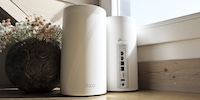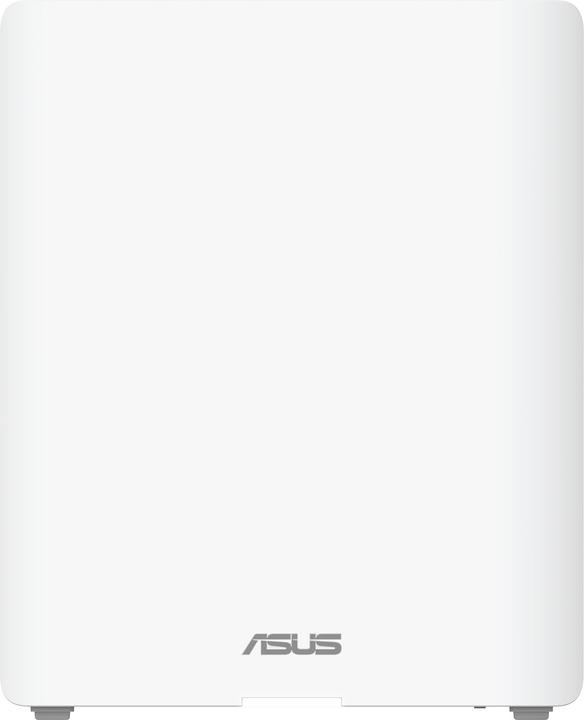

Wi-Fi tested: Asus ZenWIFI BQ16 in a double pack
With a Wi-Fi 7-capable mesh system from Asus, I hope to achieve complete coverage of two storeys over 178 m². It just about manages this in the test and also ensures high data rates.
I moved into a two-storey loft conversion in an old house. Most of the space between the floors is made of wood. Radio waves get through better than with concrete or even reinforced concrete. However, the elongated layout of the flat and its size of just over 178 square metres are likely to pose a challenge for Wi-Fi coverage. Two Asus ZenWIFI BQ16s, which are capable of Wi-Fi 7 and together form a mesh system, were used as the first test devices.
The hardware and its features
If you want to install multiple Wi-Fi access points, some manufacturers offer mesh systems consisting of two categories of devices: a mesh router to which the modem is connected and one or more mesh repeaters. This is different with Asus. Here you always get several routers, which then either take on the leading role on the software side or act as a mesh repeater/satellite. I like that. On top of that, Asus also offers the option of mixing new routers with old ones to create a mesh.
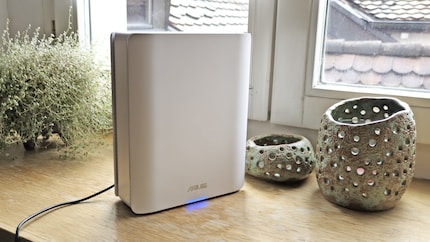
Source: Martin Jud
The two test devices are provided by the manufacturer. With the ZenWIFI BQ16, you get a Wi-Fi 7-capable router with twelve antennas and four frequency bands. These operate once in the 2.4 gigahertz (GHz) range, twice in the 5 GHz range and once in the 6 GHz range. The second 5 GHz frequency band is used as standard for the connection between the router and satellite (known as backhaul). In theory, your end devices receive a higher data throughput at higher frequencies. However, lower frequencies have a greater range with the same transmission power.
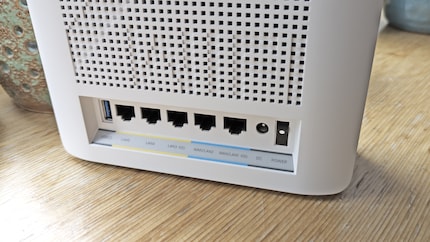
Source: Martin Jud
Asus serves your devices with a maximum of four antennas (4×4 MU-MIMO) per frequency band. A single device can theoretically receive the maximum speed if it also has four antennas. Smartphones, for example, only have one antenna and can therefore achieve a maximum of a quarter of the specified speed per frequency band. Laptops and convertibles, like the one I used for testing, are usually equipped with two antennas. The theoretical maximum data throughput is therefore limited to 2882 megabits per second (Mbps) when tested at 5 GHz, for example. If you divide this by eight, you get the megabyte value (360.25 megabytes per second).
The most important specifications:
You can find a detailed list of specifications here. If you prefer to have the router and satellite communicate via a network cable - using an Ethernet backhaul - this is also possible. However, for this article I am only testing via radio.
Furthermore, I'm mainly focussing on signal strength - how well the home is covered - speed and response time. I also don't test the data throughput when using different frequency bands at the same time, which is called multi-link operation and is only possible with Wi-Fi 7 devices. This function is activated by default at Asus, which is why I switch it off before testing. Incidentally, the function causes problems with my Wi-Fi 7 devices. It makes for a stuttering experience during SMB transfers.
I will also leave out of my tests how good other functions are - such as parental control, the integrated firewall, general operation via the web interface or app. At least as long as I don't notice any major flaws.
Apartment floor plan - router and satellite locations
Before I can start the first test in the new 178 square metre maisonette, I need an up-to-date measuring device - a notebook with Wi-Fi 7. In test measurements, I use one with AMD chip, one with Intel-Chip und eines mit Qualcomm chip. In the end, the convertible Microsoft Surface Pro with Qualcomm Snapdragon X Elite wins the race.
I then use further test measurements to determine the best locations for the router and satellite. I set up the router on the second top floor in the office (room 3 on the map below), where the Internet access is also located. The satellite is located around nine metres away in room 4. The lower floor is served entirely from above.
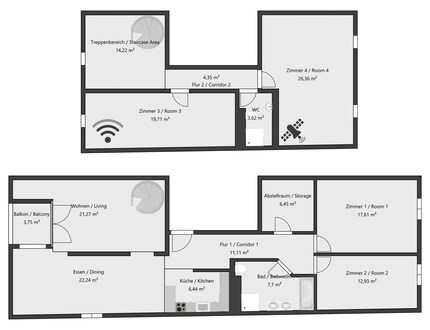
Source: Martin Jud (created with Sweet Home 3D)
Wi-Fi coverage: signal strength is sufficient in every room, but only just in some cases
To determine how well the Wi-Fi covers my home, I measure the signal strength per frequency band in each room and create heat maps from this. I use the software NetSpot.
The signal strength is measured in decibel milliwatts (dBm). Very good values correspond to -35 to -50 dBm - good to -60 dBm. From -70 dBm it becomes critical for many devices and below -80 dBm a connection is usually no longer possible. The point at which you switch to a frequency band with better reception or even to a mobile connection depends on the device in question.
Visualisation of the 6 GHz Wi-Fi coverage
In the heat maps, the wireless signal is poor wherever it goes towards dark blue. At turquoise, data throughput is already greatly reduced. Green is good. Yellow, orange and red are great.
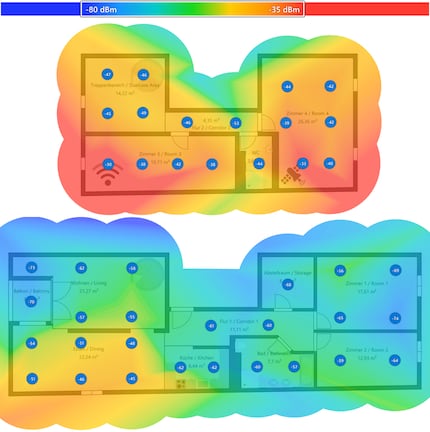
Source: Martin Jud
In case you're wondering at which measuring points the signal comes from the router and at which from the satellite: If I walk through the flat from left to right, the signal on the upper floor jumps from the router to the satellite as soon as I reach the toilet or room 4. On the lower floor, this happens in the centre of corridor 1. On the one hand, the change leads to a better signal. On the other hand, however, it also results in less data throughput due to the backhaul.
The 6 GHz frequency band with the highest data throughput covers the upper loft like a dream. On the lower floor, the balcony and the corner of the living room above, as well as Room 1 in some cases, are weak with measurement points of -70 to -74 dBm. The connection there is only just good.
Visualisation of the 5 GHz Wi-Fi coverage
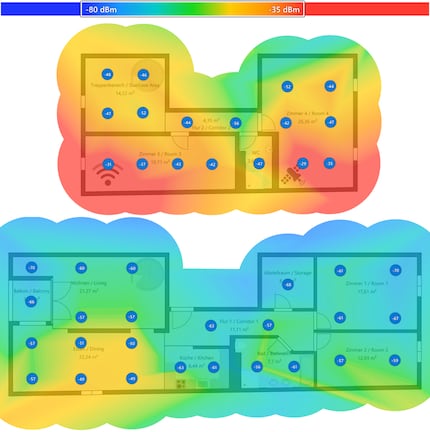
Source: Martin Jud
Under 5 GHz, the picture is almost identical to that under 6 GHz. However, the balcony is better supplied.
Visualisation of the 2.4 GHz Wi-Fi coverage
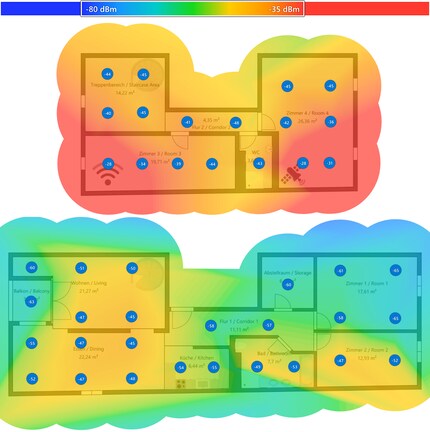
Source: Martin Jud
With the 2.4 GHz frequency band, the signal level does not fall below -65 dBm anywhere. The flat is covered as I would want any frequency band to be.
I have calculated an average value per room from the measurement points. You can find a complete list here. Summarised, the average values for the flat are as follows:
Speed
To determine the speed, I walk through the building again. I measure it by downloading from a desktop PC that has a 10 gigabit network card and is connected to the router's 10 gigabit port using a LAN cable.
The results:
If you want to study the speeds per room, you can find them (plus the dBm and ping values) here.
On the upper floor, the Wi-Fi runs at 5 and 6 GHz like I've never seen it before. But even on the lower floor, a decent speed of around one gigabit per second is achieved. The speeds achieved are some way off the theoretical data throughput. However, this is nothing special, but normal.
Except for the 2.4 GHz frequency band, which is mostly used by slow IoT devices, the average data rates are an indication of future test mesh systems.
Response time
To measure the latency in milliseconds, I ping my desktop PC.
With the Asus mesh, the response time in the home is a good 5 milliseconds on average. Even with a weaker signal, for example on the balcony, the ping only decreases slightly. A good thing for anyone who likes to game online.
In a nutshell
High data throughput, good ping and sufficient coverage
Asus gives me an average of 1279 Mbps at 6 GHz and 1143 Mbps at 5 GHz on 178 m² with two ZenWIFI BQ16s. I consider this to be decent performance. However, future tests with competitor devices will have to show whether it can be even better.
Using the 2.4 GHz frequency band, the mesh system achieves a rather meagre 168 Mbps on average. On the other hand, I like the fact that it provides the entire home with a sufficiently good signal for all end devices - even those with a weak Wi-Fi chip. This is not the case with 5 and 6 GHz. The signal coverage is weaker on the balcony, for example. As a result, devices with weak Wi-Fi integration have to switch to 2.4 GHz.
I have nothing to criticise when it comes to the consistently low response time required for online gaming, for example. Nevertheless, I can only recommend the mesh system if you want the latest Wi-Fi technology and 10 gigabit ports. In addition to the twelve antennas, it is these points that lead to the rather high price. Compared to other mesh systems with similar features, the Asus routers are in the mid-range. You can get them in packs of two and packs of three or individually.
Pro
- Router with the latest Wi-Fi 7 technology
- Twelve antennas and 4×4 MU-MIMO per frequency band
- Two 10 Gigabit ports and two Gigabit ports
- Good data throughput with 5 and 6 GHz frequency band
- Short response times
Contra
- Rather low data throughput with 2.4 GHz frequency band

I find my muse in everything. When I don’t, I draw inspiration from daydreaming. After all, if you dream, you don’t sleep through life.
